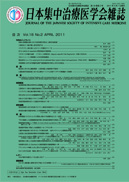Volume 18, Issue 2
Displaying 1-32 of 32 articles from this issue
- |<
- <
- 1
- >
- >|
HIGHLIGHTS IN THIS ISSUE
-
2011Volume 18Issue 2 Pages 171-172
Published: April 01, 2011
Released on J-STAGE: October 05, 2011
Download PDF (583K) -
2011Volume 18Issue 2 Pages 172-175
Published: April 01, 2011
Released on J-STAGE: October 05, 2011
Download PDF (600K) -
2011Volume 18Issue 2 Pages 176-177
Published: April 01, 2011
Released on J-STAGE: October 05, 2011
Download PDF (627K) -
2011Volume 18Issue 2 Pages 178-182
Published: April 01, 2011
Released on J-STAGE: October 05, 2011
Download PDF (750K) -
2011Volume 18Issue 2 Pages 183-184
Published: April 01, 2011
Released on J-STAGE: October 05, 2011
Download PDF (566K) -
2011Volume 18Issue 2 Pages 185-187
Published: April 01, 2011
Released on J-STAGE: October 05, 2011
Download PDF (568K) -
2011Volume 18Issue 2 Pages 188-189
Published: April 01, 2011
Released on J-STAGE: October 05, 2011
Download PDF (566K) -
2011Volume 18Issue 2 Pages 190-192
Published: April 01, 2011
Released on J-STAGE: October 05, 2011
Download PDF (665K)
REVIEW ARTICLES
-
2011Volume 18Issue 2 Pages 193-200
Published: April 01, 2011
Released on J-STAGE: October 05, 2011
Download PDF (402K) -
2011Volume 18Issue 2 Pages 201-206
Published: April 01, 2011
Released on J-STAGE: October 05, 2011
Download PDF (264K)
ORIGINAL ARTICLE
-
2011Volume 18Issue 2 Pages 207-213
Published: April 01, 2011
Released on J-STAGE: October 05, 2011
Download PDF (258K)
CASE REPORTS
-
2011Volume 18Issue 2 Pages 215-220
Published: April 01, 2011
Released on J-STAGE: October 05, 2011
Download PDF (337K) -
2011Volume 18Issue 2 Pages 221-225
Published: April 01, 2011
Released on J-STAGE: October 05, 2011
Download PDF (409K) -
2011Volume 18Issue 2 Pages 227-231
Published: April 01, 2011
Released on J-STAGE: October 05, 2011
Download PDF (394K) -
2011Volume 18Issue 2 Pages 233-237
Published: April 01, 2011
Released on J-STAGE: October 05, 2011
Download PDF (370K) -
2011Volume 18Issue 2 Pages 239-242
Published: April 01, 2011
Released on J-STAGE: October 05, 2011
Download PDF (386K) -
2011Volume 18Issue 2 Pages 243-248
Published: April 01, 2011
Released on J-STAGE: October 05, 2011
Download PDF (352K)
RAPID PUBLICATIONS
-
2011Volume 18Issue 2 Pages 249-252
Published: April 01, 2011
Released on J-STAGE: October 05, 2011
Download PDF (270K) -
2011Volume 18Issue 2 Pages 253-257
Published: April 01, 2011
Released on J-STAGE: October 05, 2011
Download PDF (395K)
BRIEF REPORTS
-
2011Volume 18Issue 2 Pages 259-260
Published: April 01, 2011
Released on J-STAGE: October 05, 2011
Download PDF (322K) -
2011Volume 18Issue 2 Pages 261-262
Published: April 01, 2011
Released on J-STAGE: October 05, 2011
Download PDF (211K) -
2011Volume 18Issue 2 Pages 263-264
Published: April 01, 2011
Released on J-STAGE: October 05, 2011
Download PDF (351K) -
2011Volume 18Issue 2 Pages 265-266
Published: April 01, 2011
Released on J-STAGE: October 05, 2011
Download PDF (214K) -
2011Volume 18Issue 2 Pages 267-268
Published: April 01, 2011
Released on J-STAGE: October 05, 2011
Download PDF (395K) -
2011Volume 18Issue 2 Pages 269-270
Published: April 01, 2011
Released on J-STAGE: October 05, 2011
Download PDF (324K) -
2011Volume 18Issue 2 Pages 271-272
Published: April 01, 2011
Released on J-STAGE: October 05, 2011
Download PDF (406K) -
2011Volume 18Issue 2 Pages 273-274
Published: April 01, 2011
Released on J-STAGE: October 05, 2011
Download PDF (267K) -
2011Volume 18Issue 2 Pages 275-276
Published: April 01, 2011
Released on J-STAGE: October 05, 2011
Download PDF (375K) -
2011Volume 18Issue 2 Pages 277-278
Published: April 01, 2011
Released on J-STAGE: October 05, 2011
Download PDF (316K) -
2011Volume 18Issue 2 Pages 279-280
Published: April 01, 2011
Released on J-STAGE: October 05, 2011
Download PDF (197K)
LETTER
-
2011Volume 18Issue 2 Pages 281-282
Published: April 01, 2011
Released on J-STAGE: October 05, 2011
Download PDF (156K)
INVESTIGATION REPORT
-
2011Volume 18Issue 2 Pages 283-294
Published: April 01, 2011
Released on J-STAGE: October 05, 2011
Download PDF (862K)
- |<
- <
- 1
- >
- >|
